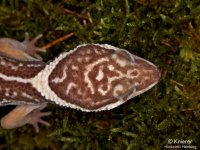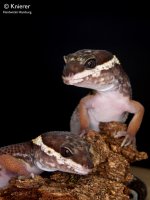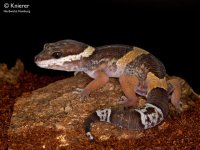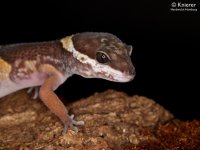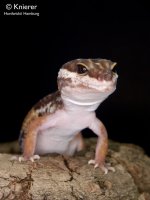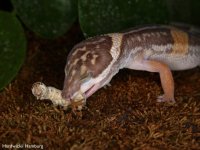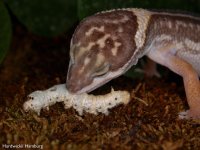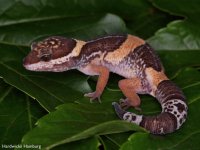You are using an out of date browser. It may not display this or other websites correctly.
You should upgrade or use an alternative browser.
You should upgrade or use an alternative browser.
My Eublepharis hardwickii (pictures and care link)
- Thread starter rhaco
- Start date
rhaco
Active member
Here are some new photos as they are now 200 days old:


And as I never posted this here, I will upload two photos of this awesome original painting of all the Eublepharis species by the artist Emily Burke. The original stays with me but she has prints available on her website: All Products · Emily Burke Artwork · Online Store Powered by Storenvy
(I hope it's ok to advertise a little. But she is a very talented artist and I think a lot of Eublepharis keepers would love a print of this special artwork!)
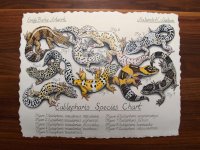
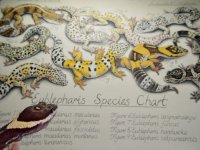


And as I never posted this here, I will upload two photos of this awesome original painting of all the Eublepharis species by the artist Emily Burke. The original stays with me but she has prints available on her website: All Products · Emily Burke Artwork · Online Store Powered by Storenvy
(I hope it's ok to advertise a little. But she is a very talented artist and I think a lot of Eublepharis keepers would love a print of this special artwork!)


Check out the Gecko Time article on Emily Burke and her reptile sculptures here: Reptiles: An Artistic Perspective - Gecko Time - Gecko Time
Aliza
Aliza
rhaco
Active member
Update at 7 months of age:
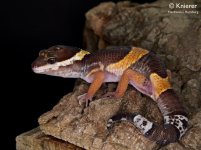

In addition I want to share some information about how Eublepharis hardwickii lives in the wild.
Little information on the husbandry of this beautiful and shy Eublepharis species can be found on the internet let alone in books.
„A little cooler and at higher humidity than the other Eublepharis species“ seems to be the general consensus.
But what it the right temperature? What is the right humidity?
Trying to answer those questions you would have to study the animals in the wild. I asked someone who travelled several times to India to research Eublepharis hardwickii.
I asked him about his findings and he allowed me to share them.
To be clear: These are not my observations, so I won’t be able to answer any questions about the following information.
I just share it here because it could be of use for a lot of people here:
- Adult animals were mainly active in June - August during raining season
- Females found at that period were still not gravid so it can be assumed that they lay their eggs later in the year
- No freshly hatched babies were found so it is unclear when babies hatch in the wild
- All juveniles found in June and July already had 12 - 15 gram and were probably hatchlings of the previous year
- The main rainfall and therefore most humid climate is from June until September; humidity gets up to 80 - 100% during these times
- In the winter it’s dry as it rains very rarely
- Wild Eublepharis hardwickii are strictly nocturnal with main activity from 7pm-10pm when it’s drizzling. If it is too dry or too wet they won’t come out
- They were only found in the forests, never near roads or cities
- They were found in forests at 600-800 meters altitude
- The temperature in the forest during their main activity months was never above 30°C and was lowering to 22-24°C at night
- From December until March no animals were found
- The coldest month is January, around 20°C at daytime, lowering to 13°C at night
- In March during the day 25 - 27 °C, at night still lowering to 13 - 15°C
Everyone can draw their own conclusions from this.
What I learned from this:
- The hot area in the terrarium should not be over 30°C and even lower at night when the animals are active
- Humidity varies a lot in the course of the year: during their active months they like high humidity but the terrarium should not be too wet
- During hibernation you do not need to spray them that much


In addition I want to share some information about how Eublepharis hardwickii lives in the wild.
Little information on the husbandry of this beautiful and shy Eublepharis species can be found on the internet let alone in books.
„A little cooler and at higher humidity than the other Eublepharis species“ seems to be the general consensus.
But what it the right temperature? What is the right humidity?
Trying to answer those questions you would have to study the animals in the wild. I asked someone who travelled several times to India to research Eublepharis hardwickii.
I asked him about his findings and he allowed me to share them.
To be clear: These are not my observations, so I won’t be able to answer any questions about the following information.
I just share it here because it could be of use for a lot of people here:
- Adult animals were mainly active in June - August during raining season
- Females found at that period were still not gravid so it can be assumed that they lay their eggs later in the year
- No freshly hatched babies were found so it is unclear when babies hatch in the wild
- All juveniles found in June and July already had 12 - 15 gram and were probably hatchlings of the previous year
- The main rainfall and therefore most humid climate is from June until September; humidity gets up to 80 - 100% during these times
- In the winter it’s dry as it rains very rarely
- Wild Eublepharis hardwickii are strictly nocturnal with main activity from 7pm-10pm when it’s drizzling. If it is too dry or too wet they won’t come out
- They were only found in the forests, never near roads or cities
- They were found in forests at 600-800 meters altitude
- The temperature in the forest during their main activity months was never above 30°C and was lowering to 22-24°C at night
- From December until March no animals were found
- The coldest month is January, around 20°C at daytime, lowering to 13°C at night
- In March during the day 25 - 27 °C, at night still lowering to 13 - 15°C
Everyone can draw their own conclusions from this.
What I learned from this:
- The hot area in the terrarium should not be over 30°C and even lower at night when the animals are active
- Humidity varies a lot in the course of the year: during their active months they like high humidity but the terrarium should not be too wet
- During hibernation you do not need to spray them that much
Elizabeth Freer
Well-known member
Thanks so much, Johannes!
Have you more eggs in the incubator? How long does it usually take from laying to hatching?
Have you more eggs in the incubator? How long does it usually take from laying to hatching?
rhaco
Active member
Thanks so much, Johannes!
Have you more eggs in the incubator? How long does it usually take from laying to hatching?
My plan is to successfully incubate at least one clutch this season. I do it just for fun and for all the loyal visitors of this GU thread and my FB page. And to maybe find the right temperature to produce males.
I only hatched the two babies from last season so far. So I cannot make a statement about average incubation time. Last season they took about 50 days.
The first clutch of this season is incubating since 40 days so far. But I am not sure they are fertile. We’ll see.
I pulled the second clutch of the season today.
I really hope I can post some new baby photos soon.
Until then, another portrait of the sisters from last season:

Elizabeth Freer
Well-known member
:banana:My plan is to successfully incubate at least one clutch this season. I do it just for fun and for all the loyal visitors of this GU thread and my FB page. And to maybe find the right temperature to produce males.
I only hatched the two babies from last season so far. So I cannot make a statement about average incubation time. Last season they took about 50 days.
The first clutch of this season is incubating since 40 days so far. But I am not sure they are fertile. We’ll see.
I pulled the second clutch of the season today.
I really hope I can post some new baby photos soon.
Until then, another portrait of the sisters from last season:
View attachment 47511
Thanks, Johannes! This thread has 24,500+ views so far! That's remarkable.
These Eublepharis harwickii have an exceptional fan club.









